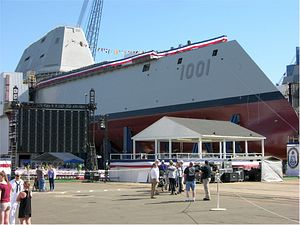The future USS Michael Monsoor, the second ship of the Zumwalt-class, the U.S. Navy’s biggest and technologically most advanced class of guided-missile destroyers, took to the sea for the first time on December 4 to conduct initial sea trials, according to ship maker Bath Iron Works (BIW).
“Michael Monsoor (DDG 1001) is currently on Builders Trials, testing the hull, mechanical and engineering components of the ship,” BIW said in a statement. “While all these systems are tested pierside, there is no substitute for the real world testing taking place in the Gulf of Maine.”
Neither the U.S. Navy nor BIW released additional details.
The future USS Michael Monsoor, named after a U.S. Navy Seal killed in Iraq in 2006 who was posthumously awarded the Medal of Honor, was launched by BIW, which is owned by U.S. defense contractor General Dynamics, in June 2016. The 610-foot-long (186-meter-long) ship is expected to be commissioned in early 2019.
The lead ship of the new class of stealth warships, the 16,000-ton next generation guided-missile destroyer USS Zumwalt (DDG 1000), was commissioned in October 2016. The ship is expected to become operational next year.
As I reported earlier this year, senior U.S. naval officers have offered to dispatch the USS Zumwalt to South Korea to underline U.S. defense commitments to Seoul and help deter North Korean aggression. “Armed with SM-1, SM-2 and SM-6 missiles (fired from the ship’s Mk 57 Vertical Launch System), the Zumwalt can be used for ballistic missile defense,” I explained.
Zumwalt-class multi-role destroyers feature wave-piercing tumblehome hulls and a futuristic stealth design that reduces the ships’ radar signatures.
“There are also considerations to equip the ship with lasers and other high-tech weapons in the future given the Zumwalt’s new integrated power system that can produce approximately 78 megawatts of power–almost as much as a nuclear-powered aircraft carrier,” I explained. “The U.S. Navy is currently evaluating a replacement for the primary projectile used for Zumwalt’s two main guns.”
As I wrote last year:
With a cost of $800,000 to $1 million per Long Range Land Attack Projectile (LRLAP) round, the precision ammunition has become too expensive for the service. LRLAP is the only ammunition specifically designed to be fired by the USS Zumwalt’s two 155 millimeter/62-caliber Advanced Gun Systems (AGS), the main armament of the ship with an estimated range of up to 63 nautical miles (72 miles, 115 kilometers).
The U.S. navy is evaluating three options: Raytheon’s 155 millimeter Excalibur 1b, BAE Systems’ Multi-Service Standard Guided Projectile (MS-SGP), and the Hyper Velocity Projectile (HVP).
Given that the class still lacks its main weapon system, senior naval officials are considering revamping the Zumwalt-class’ principal mission from long-range precision gunfire against land targets to a surface strike platform capable of engaging enemy surface ships at long range, USNI News reports this week.
“We terminated LRLAP last program, and we said we’ve got to go look at where we want to go with that gun,” U.S. Navy Rear Admiral Ron Boxall told USNI News this week. “So looking at where we go with that gun, how we can take advantage of what that ship is good at, and come up with a new set of requirements.”
The Zumwalt-class is fitted with eighty MK57 vertical launch tubes, each capable of accommodating one to four missiles of all variants. The ships also carry Tomahawk missiles, torpedoes, and anti-submarine rockets.
“You’ll hear more about this as we go forward with it, but the gist of it is, the big takeaway is, we see an opportunity with this ship, with its ability to carry the weapons it can carry and the types of design we put into it for signature control, that we think is a very good platform to be used forward as a surface strike platform,” Boxall added.
A third Zumwalt-class stealth destroyer is currently under construction at BIW in Bath, Maine.

































